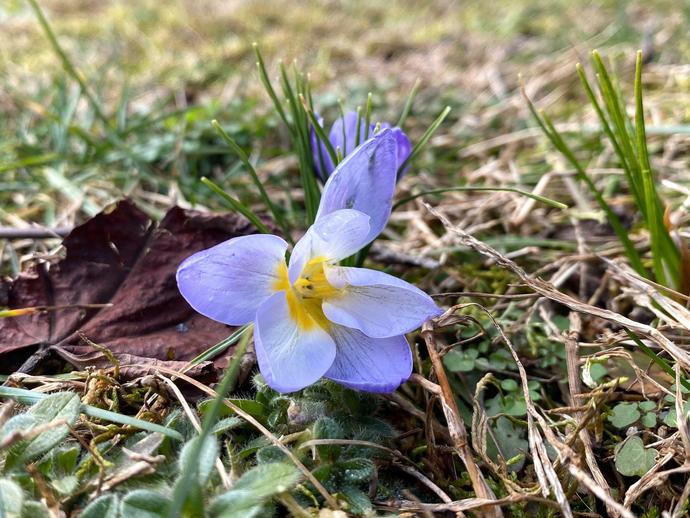February 17, 2021
Ben here with today's #BenInNature update presented by our friends at Carter Bank & Trust!
Even though everything seems to be getting covered in ice once a week right now, there are a few plants that are managing to thrive, such as this crocus I spotted in my front yard yesterday morning!
Crocuses are a genus of perennial flowering plants in the iris family, and there are about 90 different species. They grow from corms, which are basically thick underground plant stems that store energy to help plants survive harsh conditions. Corms are not quite the same thing as bulbs; the way to tell the difference is that if you cut a corm in half, it appears to be constructed of a solid layer of plant tissue, but if you cut a bulb in half, it will appear to be made up of overlapped layers that are actually modified leaves.
Crocuses are found quite commonly in the U.S., although they are not native to North America. They're actually native to North Africa, the Middle East, central and southern Europe, and much of Asia. However, they have been cultivated all over the world and are beloved by gardeners for their tendency to bloom in very early spring, even when there's snow on the ground!
If you're a fan of the spice saffron, you have the crocus to thank. The spice comes to us from the crocus species Crocus sativa; the stigma and styles of the flower, also called "threads," are collected and sold as saffron. Given that these plant structures are pretty small, it can take about 75,000 crocus flowers to make one pound of saffron. When you combine that with the fact that the harvesting of the structures must be done manually, it's no surprise that saffron is the most expensive spice in the world and can cost as much as $5,000 per pound!
ABOUT #BenInNature
Social distancing can be difficult, but it presents a great opportunity to become reacquainted with nature. In this series of posts, Administrator of Science Ben Williams ventures outdoors to record a snapshot of the unique sights that can be found in the natural world. New updates are posted Monday - Friday, with previous posts highlighted on the weekends. This series of posts is made possible thanks to the support of VMNH Corporate Partner Carter Bank & Trust (www.cbtcares.com)
NATURE PHOTO IDENTIFICATIONS
If you discover something in nature that you would like help identifying, be sure to message us right here on Facebook with a picture (please include location and date of picture) and we'll have our experts help you identify it!

 Hours & Admissions
Hours & Admissions Directions
Directions

